{english below} Cuando éramos unos críos nos deleitó un skater en rampa llamado Chris Miller, por su solidez, perfección y fluidez encima de la tabla, junto a un estilo inconfundible y diferente. Toda esta mezcla hacía que te sintieras atrapado por el patín de Chris. Además, Chris es de esa generación de skaters como Neil Blender o Andy Howell que hacían sus propios gráficos, y sus tablas hoy día se han convertido en toda una referencia del skate art, con sus gráficos modernistas y tan originales para la época. Mas tarde Chris fundo Planet Earth, una marca mítica de los 90, y desde entonces no ha parado. En la actualidad Chris sigue patinando y siendo una de las personas mas creativas en la industria del skateboard, gracias al trabajo que realiza desde su agencia MODV. Hemos tenido la suerte de poder sentarnos con él y charlar de su carrera en el skate y muchas mas cosas.
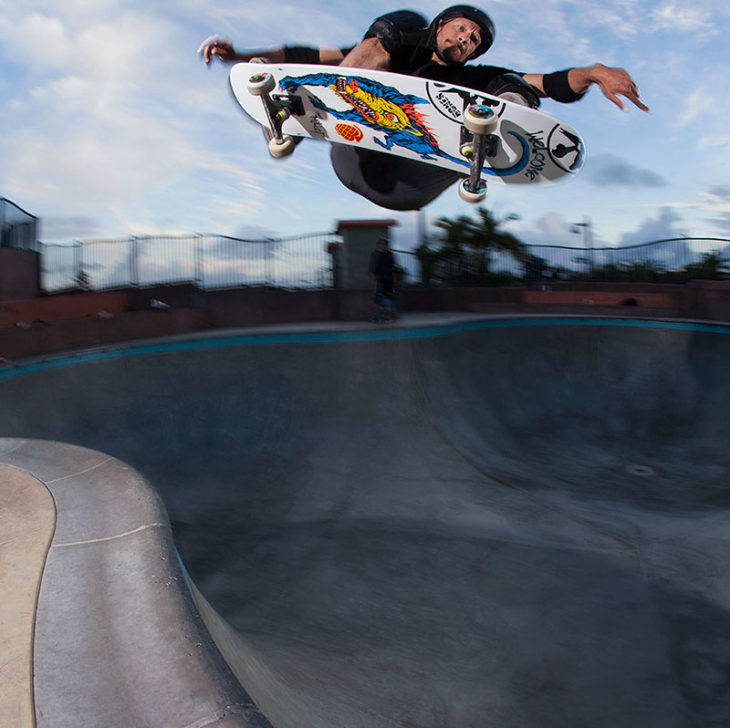
Cuentanos de tu infancia, tus inicios en el skateboard…
Nací en el norte de California, pero crecí sobre todo en el sur…, en la zona de Los Ángeles. Primero en Santa Mónica, donde me inicié en el monopatín. Era el momento álgido de la era Dogtown, y aunque era demasiado joven para participar directamente en esa escena, el skate y el surf eran una parte importante de la cultura juvenil en Santa Mónica. Entonces mis padres se separaron y me mudé a Claremont con mi madre. Me deprimía alejarme de la costa, pero resultó que estábamos cerca de Upland, sede del Pipeline Skatepark. Allí es donde el skateboarding se convirtió realmente en mi pasión. Estuve en el parque patinando casi todos los días desde los 10 hasta los 18 años. Se convirtió en mi vida.

¿Cómo te metiste en el mundo del arte y los gráficos?
Desde que era un niño, siempre estaba dibujando y haciendo arte. Antes de hacer mi primer gráfico de G&S, no pensaba que fuera a ganarme la vida con ello. Lo que sucedió fue que me hice profesional y mi primera tabla de G&S salió y ellos hicieron los gráficos, pero me decepcionó mucho cómo salió. Así que acordaron hacer algo diferente con mi aportación. Les di la idea y el artista que estaba trabajando en ella la interpretó de forma completamente diferente a lo que yo había pensado. Lo intentaron un par de veces y no consiguieron hacerlo bien… Neil Blender también estaba en G&S y era el único profesional de la época que yo conocía que había diseñado sus propios gráficos. Básicamente, él sabía que yo podía dibujar y hacer arte, así que me animó a hacer mi propio gráfico. Sin Neil, no estoy seguro de que lo hubiera hecho… No estaba seguro de poder hacer algo lo suficientemente bueno, pero lo intenté y me salió muy bien. Esa fue la cara con la persona que se cae, y después de eso hice todos mis propios gráficos y algunos para otros amigos también. Con el tiempo, eso me llevó a crear Planet Earth, que en cierto modo fue un gran proyecto artístico para mí…
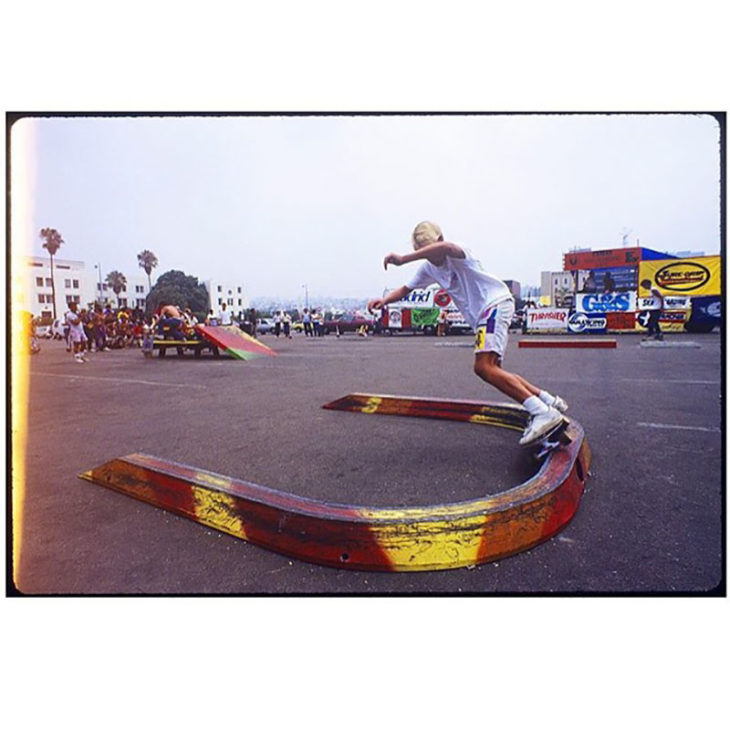
¿Cuáles fueron tus influencias en el arte pop, diseño, música…?
Soy un amante de la música, pero no soy un fanático en el que ciertas bandas o una escena impulsaron mi vida y estilo. Por supuesto, me gustaba la música punk de principios de los 80, que formaba parte del skateboarding, cosas como los Clash, Ramones, Sex Pistols, etc., pero también me gustaban sonidos más diversos y eclécticos que estaban por todo el mapa, desde Bob Marley a los primeros Bowie, los Jam, Bauhaus, Joy Division. Más tarde, bandas como The Chameleons y The Smiths. En cuanto a las artes visuales, me influyó el arte de los álbumes y entraba en las tiendas de discos para ver las portadas. Esto fue antes de internet, por supuesto, así que me pasaba horas mirando las portadas de los discos… sin saber ni preocuparme de qué banda o quién era el diseñador… sólo me gustaba el arte. Probablemente fue aquí donde me enamoré del diseño gráfico. También el arte de los libros de rock con el arte psicodélico del rock de los años 60 y 70. También me encantan los museos y las galerías de arte y visitaba todo lo que podía, incluso cuando era adolescente. Van Gogh, Picasso, Klimt, Scheile, Gauguin, Matisse, etc. El arte me conmueve mucho.
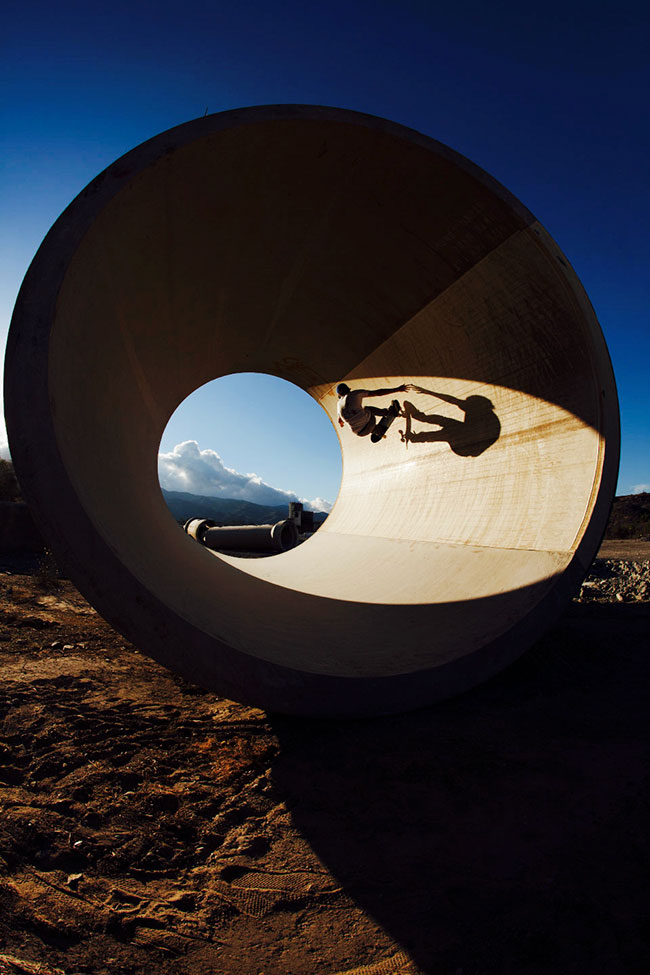
¿Cómo era el skateboarding cuando empezaste? ¿Cómo era el ambiente de tu ciudad en aquella época?
Sin duda, me influyó el estilo de surf / skate de finales de los 70 y cuando empecé a meterme en él, era grande. Tony Alva, Jay Adams y gente así parecían estrellas del rock… pero luego, cuando me metí de lleno en el mundo del patin, básicamente la cosa murió. Sólo quedaban unos pocos parques y apenas había nadie en mi escuela aparte de mí que patinara. El skatepark Pipeline se convirtió en mi hogar espiritual… pero era sólo una pequeña escena de patinadores devotos. Creo que era genial porque todos teníamos una profunda conexión por ser tan underground.
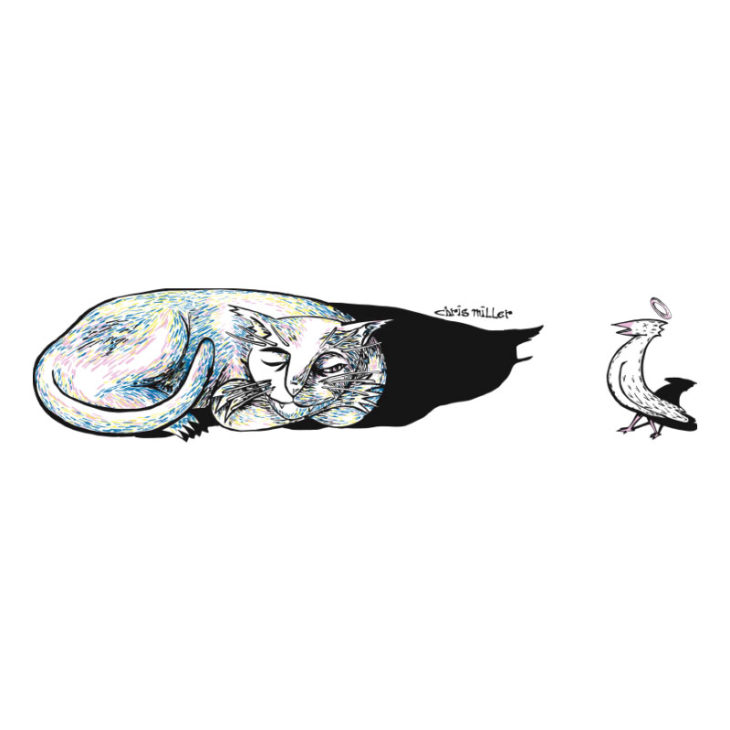
¿Cuál es la historia de Gordon & Smith? Era un referente en los años 70-80…
Bueno, como he dicho la escena del skate era bastante pequeña, y solo quedaban unos pocos parques en California. Empezamos a viajar a otros parques como Marina del Rey o Del Mar en San Diego y Skate City en Whittier para las competiciones. Sólo quedaban unas pocas empresas en la industria que patrocinaban a los patinadores y promocionaban las competiciones y apoyaban la escena en ese momento. Mi primer patrocinador fue Santa Cruz. Debido a que crecí en Pipeline y fui tomado bajo el ala de Steve Alba… el básicamente me patrocinó y más tarde fui patrocinado por la compañía. Pero Santa Cruz parece apoyar más la escena profesional que la amateur. Tanto G&S como Gullwing eran muy activos en el patrocinio de patinadores en el mundo amateur… Mis amigos como Neil Blender y Billy Ruff y otros fueron patrocinados por G&S. Al final acabé uniéndome a ellos porque me pareció que encajaba mejor que Santa Cruz… Creo que la influencia del surf también tuvo que ver con eso, ya que G&S era una empresa de tablas de surf además de patines.
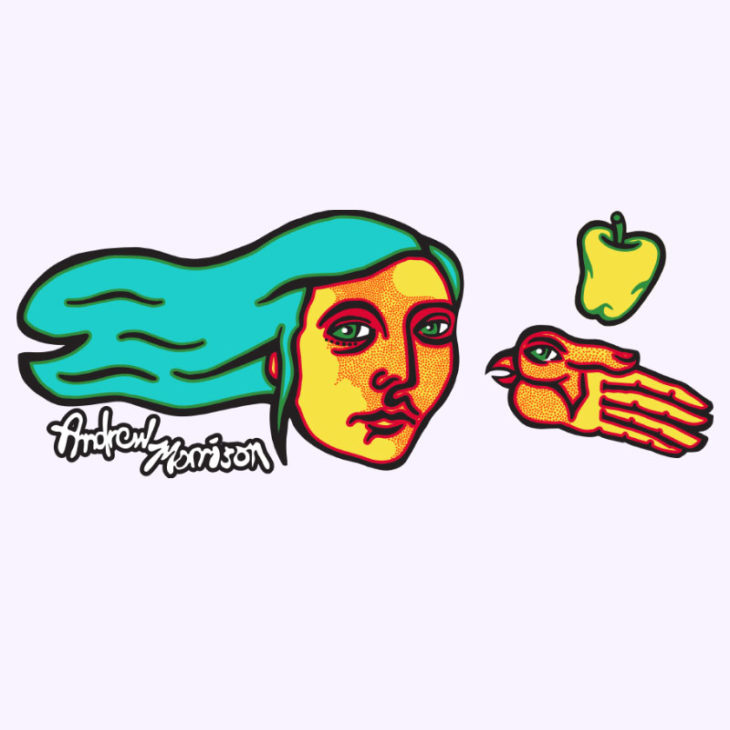
En nuestra opinión, tus gráficos y diseños son de los más interesantes que existen en la historia del skateboarding, los primeros en hacer gráficos diferentes, como Blender o Templeton… ¿Por qué crees que no son tan conocidos como otros artistas, Gonz, VC Johnson, Sean Cliver, Jim Phillips, etc …?
Gracias por eso… Como he dicho, me influyó una gama de estilos muy amplia y quizás porque estaba prestando atención al mundo del diseño gráfico y del arte en general se coló en mi trabajo. Neil Blender fue la primera persona que hizo que los gráficos de monopatín se basaran en la expresión personal y reflejaran la influencia o el estilo del patinador frente a lo que la empresa quisiera hacer. En mi caso, lo que hice fue intentar expresarme artísticamente y mis gráficos son simplemente lo que salió… No estaban muy calculados en un sentido comercial, o pensados como un producto, en cuanto a lo que se vendería mejor. Intenté crear cosas que fueran autoexpresivas y que transmitieran un cierto estado de ánimo o energía. En cuanto a mi popularidad o notoriedad…, no estoy seguro… Creo que tal vez se deba a que me autopromociono menos o ¿quizás porque me adentré en el mundo de los negocios y el diseño en lugar de seguir la ruta de ser un artista puro?…
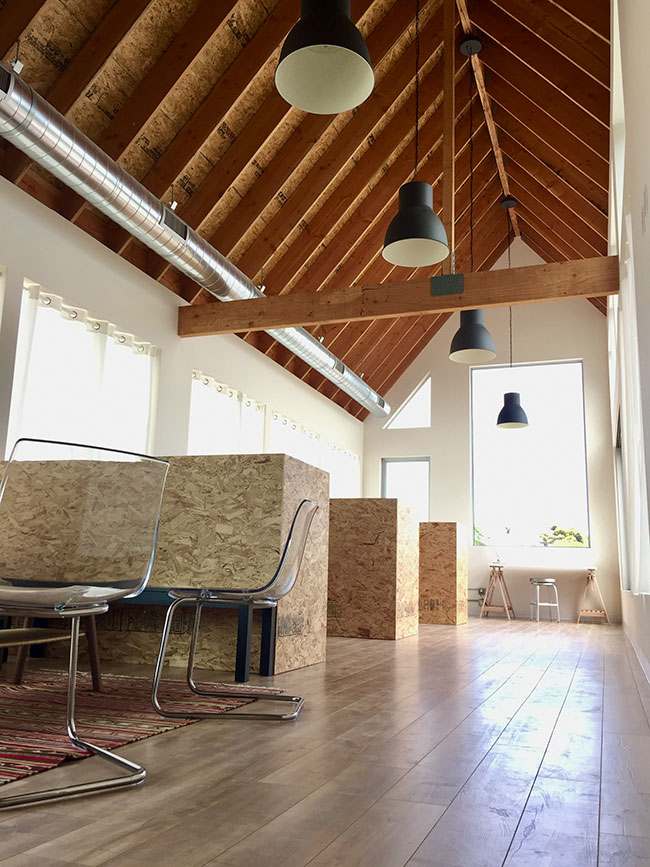
En la epoca que patinabas de forma profesional, todo el mundo parecía tener una influencia gráfica muy heavy metal, punk, terror… sin embargo tu trabajo es más bien pop, bauhaus, estilo gráfico suizo… ¿Cuáles fueron tus influencias?
Sí. El modernismo, el arte pop, el diseño suizo, todo eso. Hubo tanto arte de álbumes en esa época de finales de los 80 y principios de los 90 que me encanta, que me influyó todo. Pero también se trataba de una expresión personal y de transmitir un estado de ánimo o, en algunos casos, una historia o una emoción que de alguna manera reflejara mi personalidad.
¿Para qué marcas trabajaste más en los años 80 y, en general, para cuáles has trabajado?
G&S, Schmitt Stix y Planet Earth fueron las principales en esa época. Welcome es la empresa con la que trabajo en exclusiva ahora para las reediciones y reinterpretaciones de mis antiguos gráficos de todas esas marcas. Estoy muy orgulloso de lo que hemos hecho con Welcome para recuperar esos diseños de una manera moderna y fresca y que los jóvenes patinadores actuales realmente las patinan y aman…. ¡y yo también! ¡Jaja!
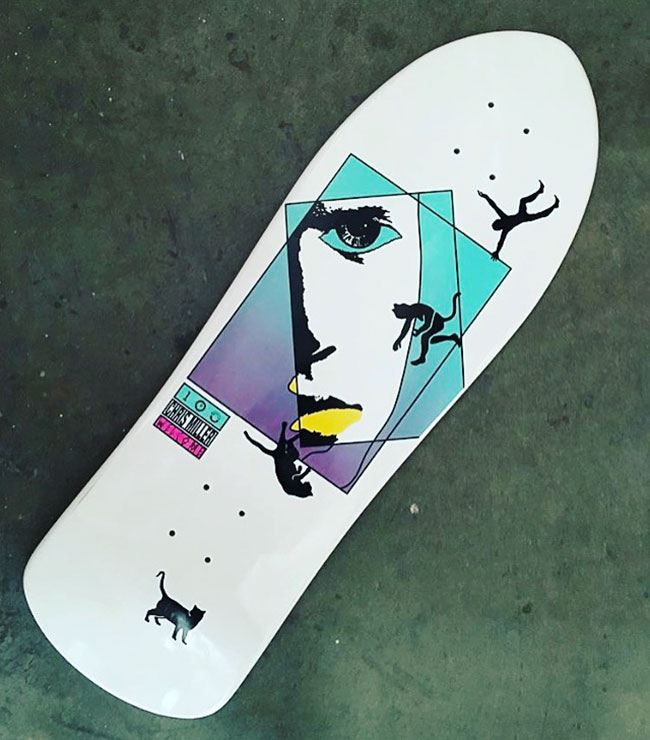
¿Cuáles son tus gráficos favoritos y por qué?
Probablemente mis dos primeras tablas de G&S… Creo que hay algo realmente puro y simple en ellas. Me encanta el de la cara, que es un autorretrato. Probablemente porque fue mi primer gráfico producido y los colores son geniales. Y luego me encanta el de la lagartija porque es de una impresión en bloque de linóleo y me gusta su simplicidad y energía. También me gustan mucho las formas del tablero, que quizá ahora vea con un poco de nostalgia, pero creo que son muy chulas.
¿Cómo ves la escena y la industria del skate en la actualidad?
Creo que en este momento, con todas las nuevas compañías de skate pequeñas que son impulsadas por diferentes patinadores que comienzan sus propios proyectos, es muy bueno… Durante un tiempo se estaba volviendo tan grande y “deportivo”, que creo que en cierto modo ha perdido parte del alma artística que estaba presente en la época en que crecí. En muchos sentidos, creo que esa es la razón por la que todas las reediciones y los gráficos de los años 80 siguen siendo tan populares… Hay algo que se plasmó en ellos que es puro en su esencia y que ha faltado en la era más reciente de los grandes negocios, los x games, la street league y las olimpiadas.
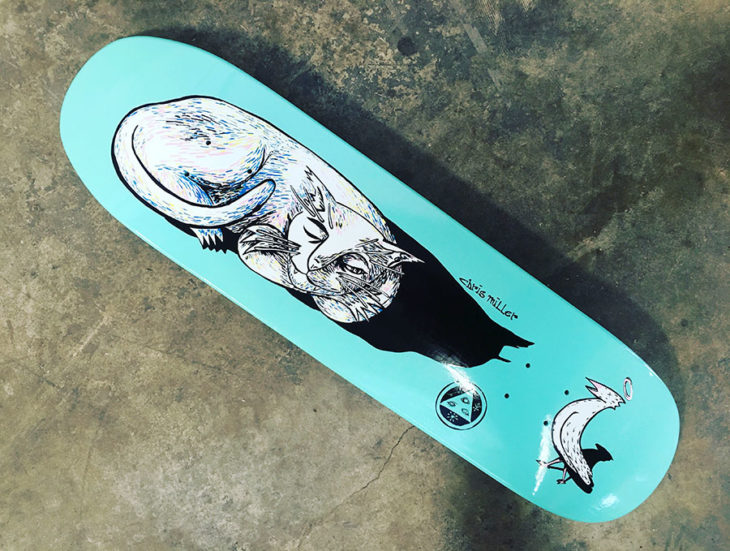
¿A qué te dedicas actualmente? ¿Sigues haciendo trabajos gráficos de Skate, u otros soportes?
Además de los monopatines y el diseño gráfico, desde los años 90 he sido un emprendedor creando múltiples empresas. También he hecho diseño de ropa y calzado. Hace unos años ayudé a crear una marca de ropa llamada Vuori, de la que soy miembro estratégico.
Ahora, tengo una pequeña agencia creativa llamada MODV group donde hacemos trabajos para clientes y también incubamos nuevos proyectos y marcas. Además, trabajo con Welcome skateboards para producir los monopatines que actualmente utilizo.
Me he interesado mucho por la arquitectura y el diseño de viviendas. A lo largo de los años he hecho algo de diseño propio y he renovado tanto oficinas como espacios comerciales. Luego me asocié con un amigo arquitecto donde tomamos un antiguo taller de reparación de automóviles, y lo renovó para convertirse en un restaurante muy fresco, cafetería y bar de vinos en Carlsbad California llamado Campfire. Esa experiencia y trabajar con él me inspiró a hacer más de eso, así que estoy a punto de saltar en un nuevo proyecto de renovación residencial que estoy emocionado. Sigo creando arte y fotografía, hago bastante surf, patino y vivo en Ojai California con mi esposa Lauren y nuestro perro llamado Cookie.
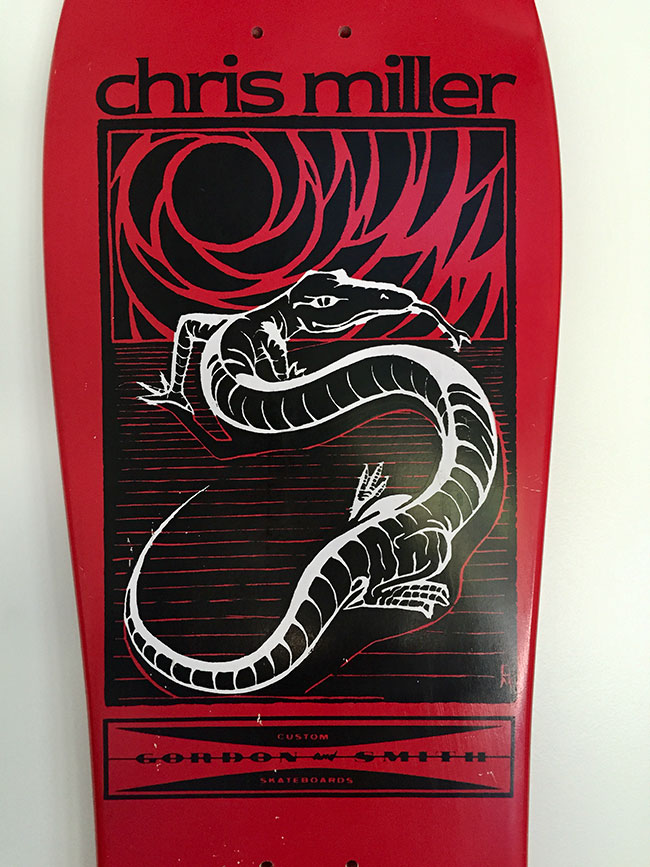


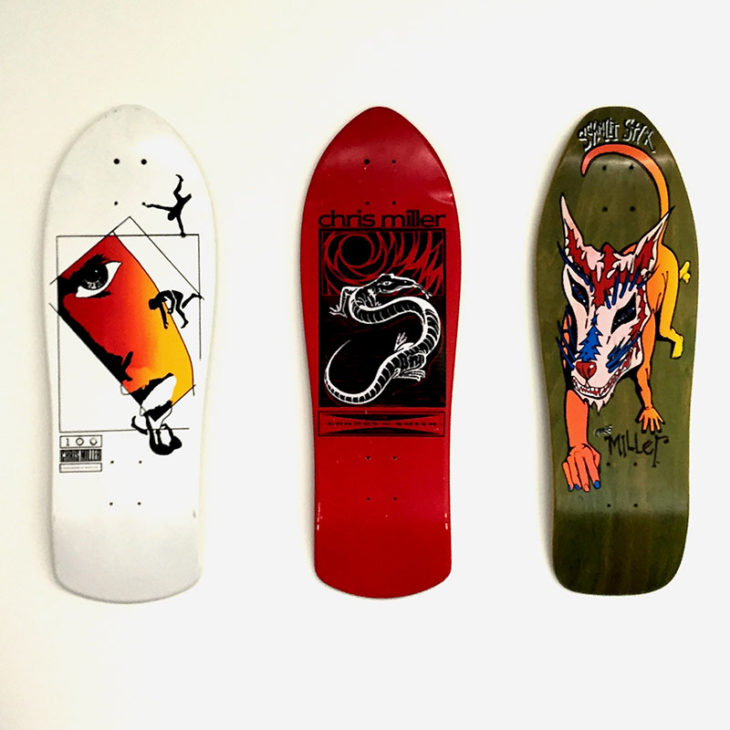
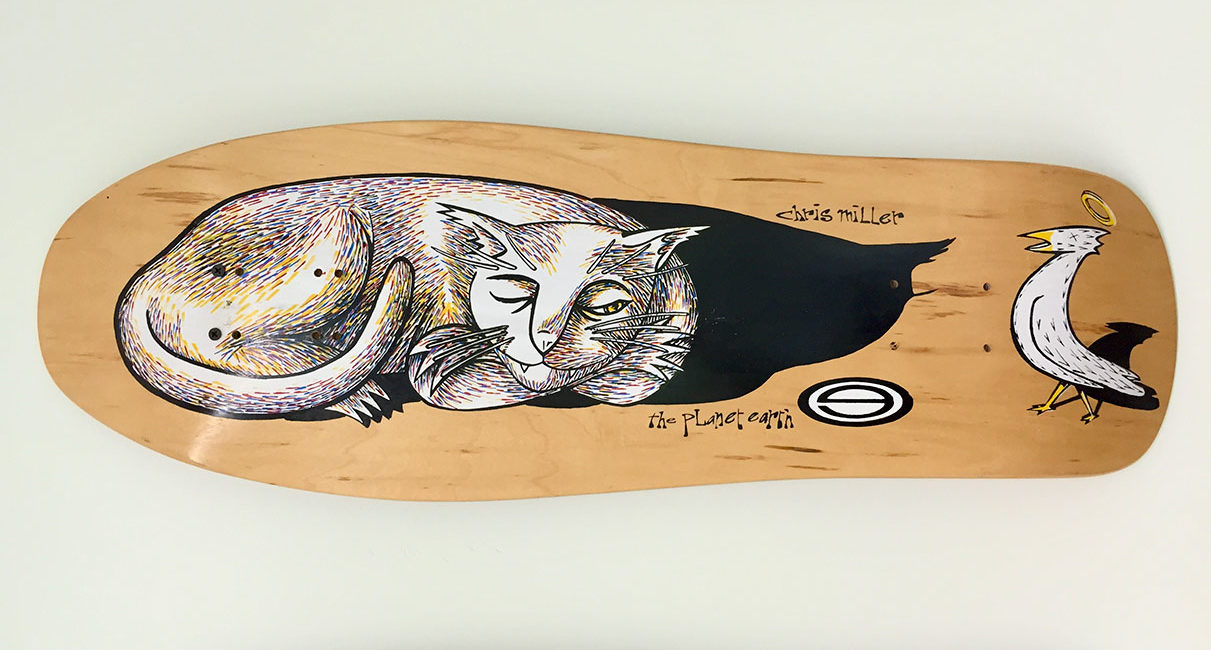

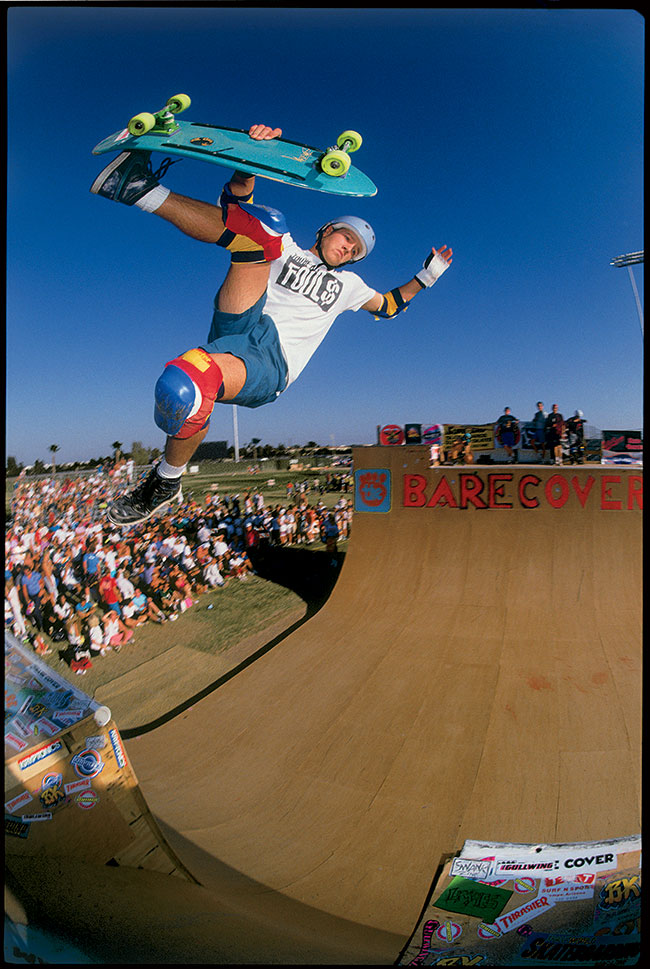
*
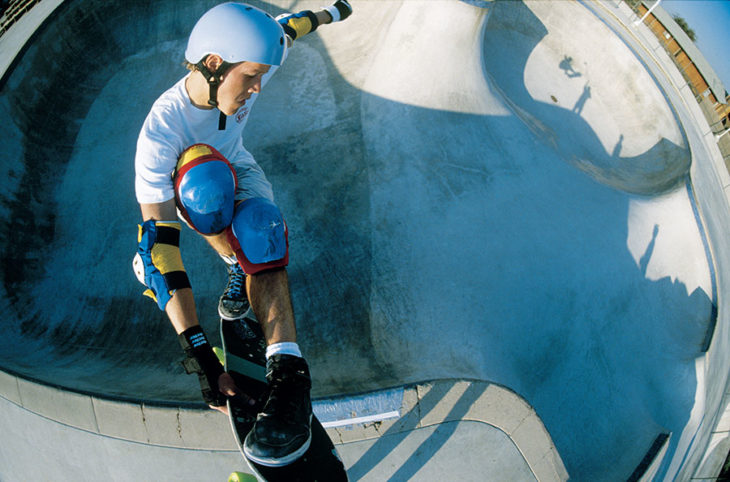
*
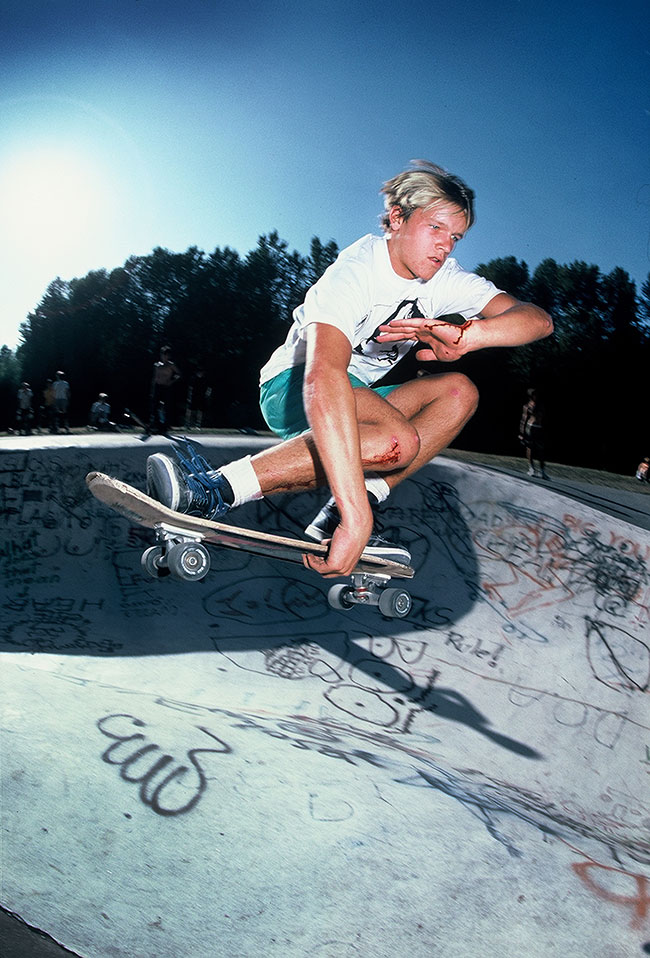
*

*

*
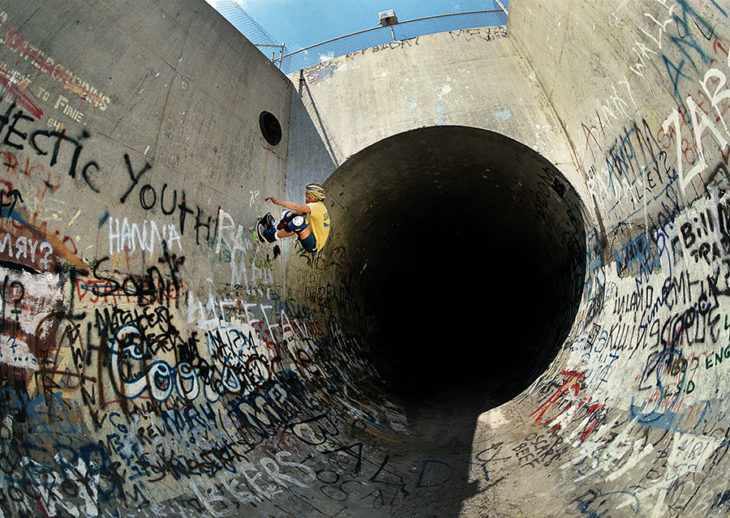
*
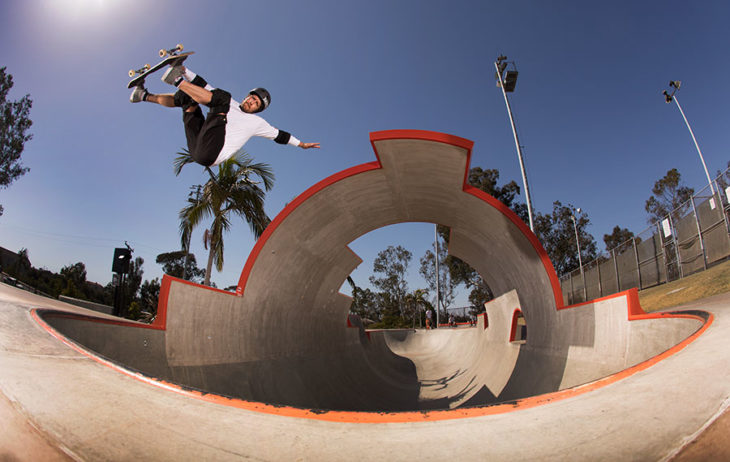
*
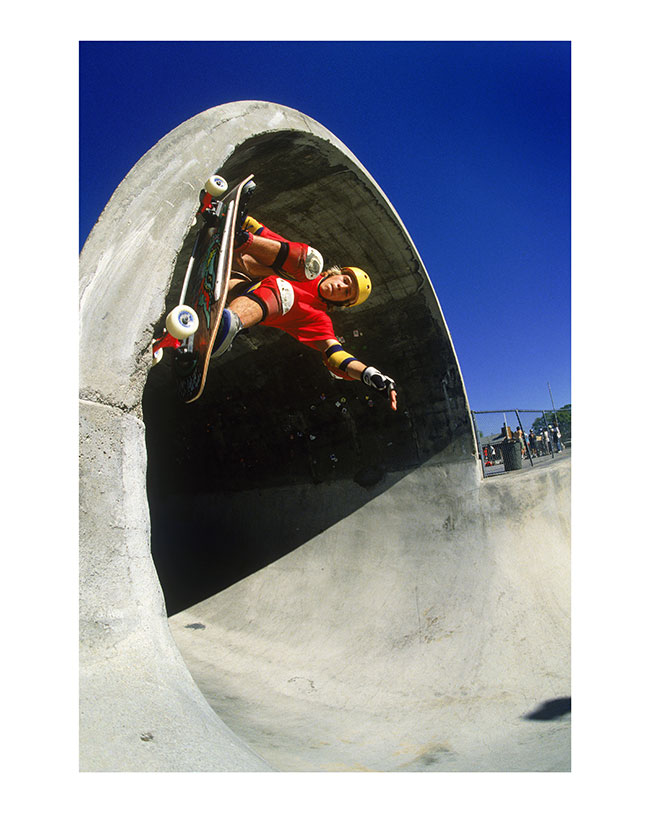
*

*

*

English:
CHRIS MILLER. STYLE MASTER
When we were kids, we were delighted by a ramp skater named Chris Miller, for his solidity, perfection and fluidity on the board, along with an unmistakable and different style. All this mixing made you feel trapped by Chris’s skateboard. In addition, Chris is from that generation of skaters like Neil Blender or Andy Howell who made their own graphics, and his boards today have become a reference in skate art, with their modernist graphics and so original for the time. Later Chris founded Planet Earth, a mythical brand from the 90s, and since then it has not stopped. Today Chris continues to skate and is one of the most creative people in the skateboard industry, thanks to the work he does from his agency MODV. We have been fortunate to be able to sit down with him and chat about his skateboarding career and much more.
Where were you born? How did you grow up in your youth? What were your interests, hobbies when you were a kid? How did you know about skateboarding?
I was born in Northern California, but grew up mostly in Southern Cal…, in the Los Angeles area. First in Santa Monica, where I picked up skateboarding. This was the peak of the Dogtown era, and while I was too young to be directly involved in that scene, skateboarding and surfing was a big part of youth culture in Santa Monica. Then my parents split up and I moved to Claremont with my Mom. I was depressed about moving away from the coast, but it turned out that we were close to Upland, home of the Pipeline Skatepark. That is where skateboarding really became my passion. I was at the park skating nearly every day from 10 years old to 18. It became my life.
How did you get into the world of art and graphics?
Since I was a kid, I was just always drawing, and always making art. Before I did my first G&S graphic, I wasn’t thinking it was something I would make a living from. What happened was I turned pro and my first G&S board came out and they did the graphics, but I was really disappointed in how it came out. So then they agreed to do something different with my input. I gave them the idea and the artist who was working on it interpreted it completely different than I envisioned. They tried a couple times and couldn’t get it right… Neil Blender was also on G&S and was the only pro at the time that I knew who had designed his own graphics. Basically, he knew I could draw and make art, so he encouraged me to just do my own graphic. Without Neil, I am not sure if I ever would have done it…I was kind of unsure if I could do something good enough, but I tried and it turned out great. That one was the face with the falling person one, and after that I did all of my own graphics and a few for other friends as well. Eventually, that lead me to create Planet Earth, with was in some ways a big art project for me…
What were your influences on pop art? From music, pop, etc …?
I am a lover of music, but I am not a fanatic where certain bands or a scene drove my life and style. I was of course into the early 80’s punk music that was such a part of skateboarding, things like the Clash, Ramones, Sex Pistols, etc. but I was also into more diverse and eclectic sounds that were all over the map from Bob Marley to early Bowie, the Jam, Bauhaus, Joy Division. Later bands like the Chameleons and the Smiths. As for visual art, I was influenced by album art and would go into record stores to just look at art. This was pre-internet of course so I spent hours just looking at album cover art… not even knowing or caring which band or who the designer was… just liking the art. This is probably where I fell in love with graphic design. Also, the art of rock books with psychedelic rock art from the 60’s and 70’s. I also love art museums and galleries and would visit whatever I could even as a teenager. Van Gogh, Picasso, Klimt, Scheile, Gauguin, Matisse, etc. I was am very moved by art.
What was skateboarding like when you started? How was your city atmosphere back in the day?
I was certainly influenced by the late 70’s surf / skate style and when I started getting into it, it was big. Tony Alva, Jay Adams people like that seemed like rock stars… but then when I really got into skating it basically died. There was just a few parks left and I barely had anyone at my school besides me that skated. The Pipeline skatepark became my spiritual home… but it was just a small scene of devoted skaters. I think it was cool because we all had such a deep connection because of it being so underground.
What is the Gordon & Smith story?…
Well like I said the skate scene was pretty small, and there was just a few parks left in California. We started traveling to the various other parks like Marina del Rey or Del Mar in San Diego and Skate City in Whittier for competitions. There was really only a few companies left in the industry who were sponsoring skaters and promoting the contests and supporting the scene at the time. My first sponsor was Santa Cruz. Because of growing up at Pipeline and being taken under the wing of Steve Alba… He basically sponsored me and then later I got sponsored by the actual company. But Santa Cruz seem to be more supportive of the pro scene versus the amateur scene. G&S and Gullwing both were really active sponsoring skaters in the amateur world… My friends like Neil Blender and Billy Ruff and others were all sponsored by G&S. Eventually I ended up joining them as it just seemed like a better fit for me compared to Santa Cruz… I think maybe some of the surf influence had to do with that as well since G&S was a surfboard company in addition to skateboards.
In our opinion, your graphics and designs are among the most interesting that exist in the history of skateboarding, the first to do different things, who later made blender or templeton … Why do you think they are not as well known as other artists, Gonz, VC Johnson, Sean Cliver, Jim, etc …?
Thank you for that… Like I said, I was influenced by such a wider range of styles and maybe because I was paying attention to the larger world of graphic design and art in general it crept into my work. Neil Blender was the first person to make skateboard graphics about personal expression and to reflect the influence or style of the skater versus just whatever the company wanted to do. For me what I did, was try to express myself artistically and my graphics are just what came out… They were not very calculated in a business sense, or thought of as a product, as to what would sell the best. I tried to create things that were self expressive and conveyed a certain mood or energy. As for my popularity or notoriety… I’m not sure… I think maybe it’s because I’m less self promotional or Maybe because I went on and into the world of business and design rather than just the route of being a pure artist?
In your years, everyone seemed to have a very heavy metal, punk, horror influence… however your work is more like pop, bauhaus, Swiss graphic style… What were your influences?
Yes. Modernism, pop art, Swiss design, all of it. There was so much great album art done throughout that late 80s and early 90s era that I love, I was influenced by all of it. But also, it was just meant to be personal expression and to convey a mood or in some cases a story or emotion that was somehow reflective of me.
For which brands did you work more in the 80s and in general, for which have you worked?
G&S, Schmitt Stix, and Planet Earth were the main ones in that era. Welcome is the company I work with exclusively now for re-issues and re-interpretations of my old graphics from all of those brands. I’m really proud of what we have done with Welcome to bring those designs back in a way that is modern and fresh and that current young skaters actually ride and love…. and me too! Haha!
What are your favorite graphics and why?
Probably my first two G&S boards… I think there’s something really pure and simple about them. I love the one with the face, which is a self portrait. Probably because it was my first graphic ever produced and the colors are great. And then I love the lizard one because it’s from a Linoleum block print and I like the simplicity and energy of it. Also I really like the board shapes, which I might view a little nostalgically now, but I just think they’re really cool.
How do you see the skate scene and industry today?
I think at the moment with all the new small skate companies that are driven off of different skaters starting their own projects it’s pretty cool… For a little while it was getting so big and “sport“ like, that I think in some ways it had lost some of the artistic soul that was present from the era I grew up in. In many ways I think that is why all of the old 80’s re-issues and graphics are still so popular… There’s something that was captured in them that is pure at its essence and has been lacking in the more recentera of big business, x games, street league, and the olympics.
What do you do currently? Are you still doing graphic work? Skate, or other supports?
Besides skateboards and graphic design, since the 1990’s I have been an entrepreneur starting multiple companies. I have also done outerwear, apparel and footwear design. I helped start a clothing brand called Vuori a few years ago, and I am a strategic board member there.
Now, I have a small creative agency called MODV group where we do client work and also incubate new projects and brands. Also, I work with Welcome skateboards to produce the skateboards I currently ride.
I have become very interested in architecture and home design. Over the years I’ve done some of my own design and renovating both offices and retail spaces. Then I partnered with an architect friend where we took a former auto repair shop, and renovated it to become a very cool restaurant, cafe and wine bar space in Carlsbad California called Campfire. That experience and working with him inspired me to do more of that, so I’m just about to jump into a new residential renovation project of my own that I’m excited about.
Personally, I still create art and photography, surf quite a bit, skate and live in Ojai California with my wife Lauren and our dog named Cookie.